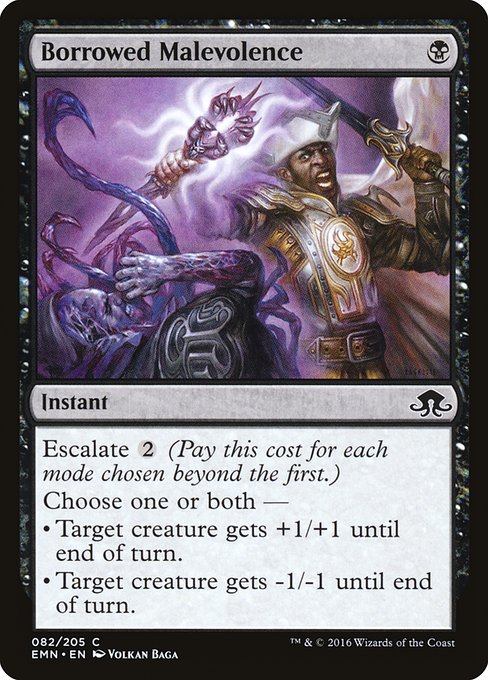
Image courtesy of Scryfall.com
Borrowed Malevolence's Role in MTG Multiverse Events
In the grand tapestry of Magic: The Gathering, some cards feel like tiny bridges between worlds, tugging at the threads that connect one plane to another. Borrowed Malevolence, a black instant from Eldritch Moon, serves as a flavorful and practical reminder that power can be borrowed, shifted, and redirected with a deft touch or a reckless surge. Its mana cost is lean—just a single black mana—yet its true heft comes from the escalated flexibility it brings to a late-game moment. 🧙♂️🔥💎
Set against the backdrop of Innistrad’s night-haunted skies, Eldritch Moon isn’t just about werewolves and angels; it’s about how fear can ripple outward, distorting alliances and forcing decisions with cascading consequences. Borrowed Malevolence embodies that vibe in a compact, rules-savvy package. The card’s core idea is simple: pick one or both effects for a creature—pump it up, or shave it down—by default, and pay more mana to add extra modes. That escalation mirrors multiverse-scale events where a single choice can ripple through multiple fronts, each outcome coloring the next. ⚔️🎨
How the Escalate Mechanic Mirrors Planar Crossovers
Escalate is a keyword that reframes a basic effect as a multi-target or multi-mode opportunity. When you cast Borrowed Malevolence for {B}, you target a creature to grant +1/+1 or -1/-1 until end of turn. If you choose to escalate by paying {2} more, you get to pick the other mode as well—tipping a creature toward resilience or frailty depending on the moment. On a crowded battlefield, this means you can swing a single pawn into a threat, then pivot to soften a larger problem across the board. It’s a hinge card—kind of like those pivotal moments when a rumor about a neighboring plane shifts the entire multiverse’s trajectory. 🧙♂️🔮
- Color and curve: As a mono-black instant, Borrowed Malevolence slots neatly into aggressive or tempo-oriented black strategies. It leverages the color’s strength in manipulating creatures, avoiding a heavy commitment to a single plan and leaving room for other disruption in the same matchup.
- Versatility on a budget: A common rarities card that can swing a board state on a dime, especially when you escalate to add both effects in the same moment. The mental math of “plus, minus, or both?” becomes a live, dynamic choice, much like deciding which rumors to chase during a multiverse event.
- Strategic timing: Holding Borrowed Malevolence for a pivotal moment—when your opponent has left a blocker unblocked or when a key attacker is about to slip through—can turn a losing exchange into a clean tempo swing. The card rewards thoughtful sequencing and live reading of the battlefield.
In the larger weave of MTG’s multiverse events, there are threads where borrowed power is a recurring motif. The Eldritch Moon storyline leans into the idea that power isn’t purely owned; it’s negotiated, redirected, and sometimes siphoned from the margins of fear and superstition. Borrowed Malevolence captures that feeling in a single spell: you glimpse a shadow power, you apply a measured push or pull, and you see the tides shift as if crossing between planes with a whispered bargain. The card’s design—grim, efficient, and just a little mischievous—embodies the tension between restraint and appetite that underpins many multiversal crossovers. 🧙♂️⚔️
Flavor, Lore, and Thematic Echoes
Volkan Bağa’s art for Borrowed Malevolence, with its stark contrasts and shadowed intensity, sells the sense of a moment when a character (or a creature) borrows a spark of malevolence to tilt a destiny. Thematically, the card echoes the echoing motifs of Innistrad’s night-bound conflicts: power borrowed from fear, consequences that ripple across a battlefield, and decisions that matter not just for the moment but for the story’s trajectory. When multiverse-scale events unfold—whether Planeswalkers crossing into shadows, or ancient powers awakening—Borrowed Malevolence serves as a compact reminder that even a single, well-timed spell can reshape outcomes across planes. 🎨🧩
In the dark loom of the Multiverse, a little borrowed power can keep a commander’s plan alive or snuff it out entirely. It’s not the raw force, but the cunning use of alternatives that writes the history books—one whispered bargain at a time.
Practical Gameplay and Commander Considerations
Outside of standard- and modern-era formats, Borrowed Malevolence finds a home in any black-focused deck where you want options, tempo, and a touch of subtle menace. For Commander players, the card scales nicely with the format’s larger boards and broader access to mana, letting you invest in the escalating modes to tailor responses to the table’s dynamic. It’s not a blowout, but it’s a steady drip of pressure that can redefine reads on your opponents’ boards. And if you’re piloting a graveyard-centric strategy, the “borrowed” concept resonates with recurring themes—stealing the thunder from a rival’s best plan and reusing it to push your own victory over the line. 🧙♂️💎
Speaking of momentum and planning, if you’re crafting a tabletop setup that blends casual play with a touch of lore-driven immersion, this card can be a thematic centerpiece. It’s a reminder that in the multiverse, sometimes the smartest move is to borrow the edge you need, just long enough to close the curtain on a dramatic turn of events. And for players who love cross-promotional gear, a well-timed Borrowed Malevolence moment can set the stage for unforgettable stories around the table. 🎲
For fans who crave a tactile connection to both strategy and story, consider pairing your deck with accessories that spark the same sense of lore. And if you’re setting up a cozy—yet competitive—tabletop scene, the product below can help you level up your game space while you plan your next big frame of multiverse mischief. ⚔️